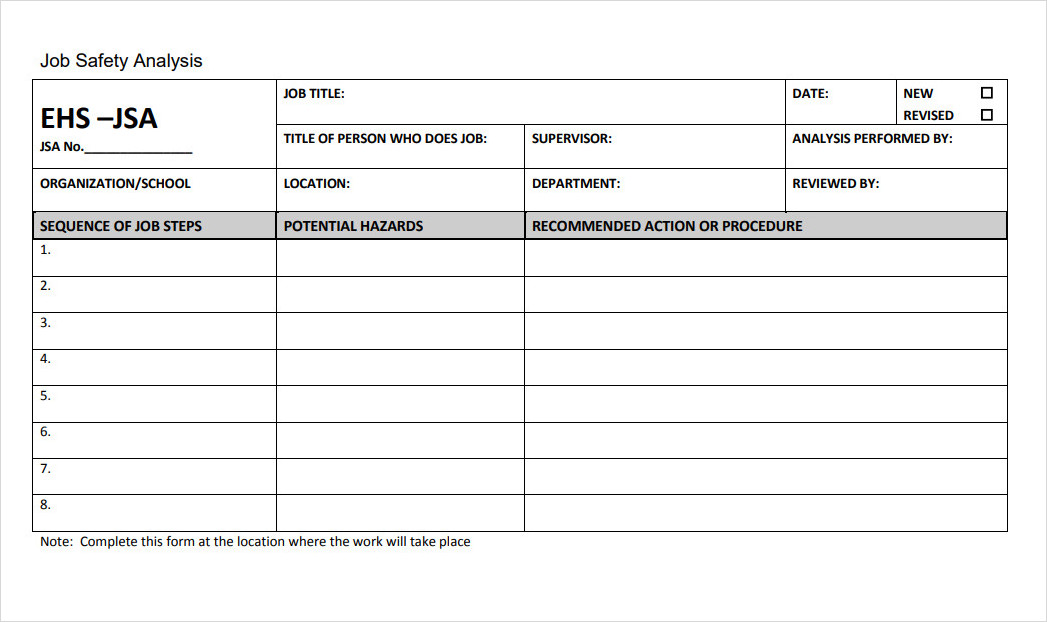
Workplace safety is of utmost importance in any industry. Employers have a responsibility to ensure the health and well-being of their employees. One effective way to achieve this is through conducting a Job Safety Analysis (JSA), also known as a Job Hazard Analysis (JHA).
A JSA is a systematic process that identifies potential hazards in a job or task and provides measures to eliminate or reduce those hazards. By conducting a JSA, employers can proactively address safety concerns and create a safe working environment for their employees.
What is a Job Safety Analysis?
A Job Safety Analysis is a document that outlines the steps involved in a particular job or task, identifies potential hazards, and provides guidelines on how to mitigate those hazards. It is usually presented in a checklist or form format, making it easy to use and understand.
The aspect of a JSA allows for easy distribution and accessibility to all employees, ensuring that everyone is aware of the potential hazards and the necessary safety measures to follow.
Why is a Job Safety Analysis Important?
A Job Safety Analysis is important for several reasons:
- Promotes Safety Awareness: By providing a comprehensive analysis of potential hazards, a JSA raises awareness among employees about the risks associated with their job or task. It helps employees understand the importance of following safety protocols and encourages them to be proactive in identifying and reporting potential hazards.
- Prevents Accidents and Injuries: A JSA allows employers to identify and address potential hazards before they result in accidents or injuries. By taking preventive measures, employers can significantly reduce the risk of workplace incidents and create a safer working environment for their employees.
- Legal Compliance: Many countries have regulations and standards in place that require employers to conduct a JSA for certain high-risk jobs or tasks. By having a Job Safety Analysis in place, employers can demonstrate their compliance with these regulations and avoid potential legal issues.
- Improves Efficiency: A JSA helps identify inefficiencies in job processes and suggests ways to improve them. By eliminating unnecessary steps or implementing more efficient procedures, employers can enhance productivity while ensuring the safety of their employees.
How to Create a Job Safety Analysis
Creating a Job Safety Analysis involves several steps:
- Select the Job or Task: Choose a specific job or task that needs analysis. It is recommended to start with high-risk jobs or tasks.
- Break Down the Job: Divide the job or task into smaller steps. This will help in identifying potential hazards more effectively.
- Identify Hazards: Analyze each step of the job and identify potential hazards. Consider both physical hazards (e.g., machinery, chemicals) and ergonomic hazards (e.g., repetitive motions, awkward postures).
- Assess the Risk: Determine the likelihood and severity of each identified hazard. This will help prioritize the hazards and focus on the ones that pose the greatest risk.
- Develop Control Measures: For each identified hazard, develop control measures to eliminate or reduce the risk. This may include engineering controls, administrative controls, or personal protective equipment (PPE).
- Communicate and Train: Share the Job Safety Analysis with all employees involved in the job or task. Provide training on the identified hazards and the necessary safety measures to follow.
- Review and Update: Regularly review and update the Job Safety Analysis to reflect any changes in the job or task, equipment, or regulations.
Examples of a Job Safety Analysis













Tips for Successful Implementation of a Job Safety Analysis
Implementing a Job Safety Analysis effectively requires proper planning and communication. Here are some tips to ensure success:
- Involve Employees: Engage employees in the JSA process by seeking their input and involving them in hazard identification and control measure development. This will increase their ownership and commitment to safety.
- Provide Training: Train employees on how to use and interpret the Job Safety Analysis. Ensure they understand the purpose of the JSA and the importance of following the identified safety measures.
- Regularly Review and Update: Keep the Job Safety Analysis up to date with any changes in the job or task, equipment, or regulations. Regularly review the JSA to ensure its effectiveness and make necessary revisions.
- Encourage Reporting: Promote a culture of reporting by encouraging employees to report any hazards or near-miss incidents they encounter. This will help identify potential hazards that may not have been initially identified in the JSA.
- Provide Resources: Ensure employees have access to the necessary resources, such as personal protective equipment (PPE), to implement the control measures identified in the JSA.
- Monitor and Evaluate: Continuously monitor and evaluate the effectiveness of the Job Safety Analysis. Seek feedback from employees and make improvements as needed.
Free Job Safety Analysis Template!
A Job Safety Analysis is a valuable tool in ensuring workplace safety. It helps identify potential hazards, provides guidelines to mitigate those hazards, and promotes safety awareness among employees.
By implementing a JSA effectively, employers can prevent accidents and injuries, comply with legal requirements, improve efficiency, and create a safer working environment. Remember to regularly review and update the Job Safety Analysis to reflect any changes and ensure its effectiveness in addressing workplace hazards.
Job Safety Analysis Template Word – Download